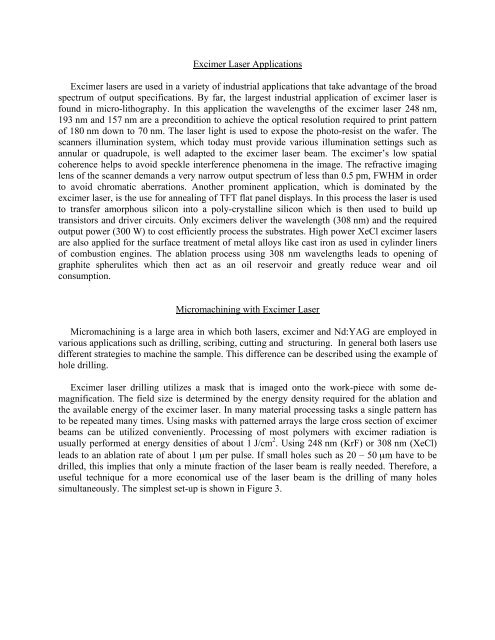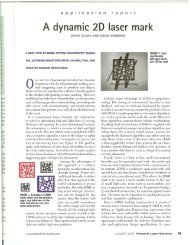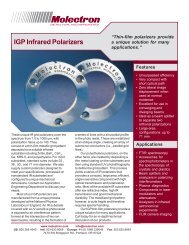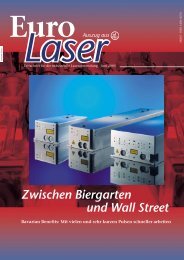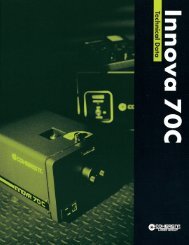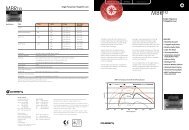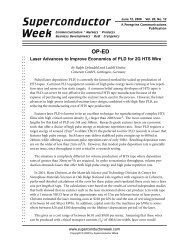Comparison Excimer Laser – Solid State Laser Rainer ... - Coherent
Comparison Excimer Laser – Solid State Laser Rainer ... - Coherent
Comparison Excimer Laser – Solid State Laser Rainer ... - Coherent
Create successful ePaper yourself
Turn your PDF publications into a flip-book with our unique Google optimized e-Paper software.
<strong>Excimer</strong> <strong>Laser</strong> Applications<br />
<strong>Excimer</strong> lasers are used in a variety of industrial applications that take advantage of the broad<br />
spectrum of output specifications. By far, the largest industrial application of excimer laser is<br />
found in micro-lithography. In this application the wavelengths of the excimer laser 248 nm,<br />
193 nm and 157 nm are a precondition to achieve the optical resolution required to print pattern<br />
of 180 nm down to 70 nm. The laser light is used to expose the photo-resist on the wafer. The<br />
scanners illumination system, which today must provide various illumination settings such as<br />
annular or quadrupole, is well adapted to the excimer laser beam. The excimer’s low spatial<br />
coherence helps to avoid speckle interference phenomena in the image. The refractive imaging<br />
lens of the scanner demands a very narrow output spectrum of less than 0.5 pm, FWHM in order<br />
to avoid chromatic aberrations. Another prominent application, which is dominated by the<br />
excimer laser, is the use for annealing of TFT flat panel displays. In this process the laser is used<br />
to transfer amorphous silicon into a poly-crystalline silicon which is then used to build up<br />
transistors and driver circuits. Only excimers deliver the wavelength (308 nm) and the required<br />
output power (300 W) to cost efficiently process the substrates. High power XeCl excimer lasers<br />
are also applied for the surface treatment of metal alloys like cast iron as used in cylinder liners<br />
of combustion engines. The ablation process using 308 nm wavelengths leads to opening of<br />
graphite spherulites which then act as an oil reservoir and greatly reduce wear and oil<br />
consumption.<br />
Micromachining with <strong>Excimer</strong> <strong>Laser</strong><br />
Micromachining is a large area in which both lasers, excimer and Nd:YAG are employed in<br />
various applications such as drilling, scribing, cutting and structuring. In general both lasers use<br />
different strategies to machine the sample. This difference can be described using the example of<br />
hole drilling.<br />
<strong>Excimer</strong> laser drilling utilizes a mask that is imaged onto the work-piece with some demagnification.<br />
The field size is determined by the energy density required for the ablation and<br />
the available energy of the excimer laser. In many material processing tasks a single pattern has<br />
to be repeated many times. Using masks with patterned arrays the large cross section of excimer<br />
beams can be utilized conveniently. Processing of most polymers with excimer radiation is<br />
usually performed at energy densities of about 1 J/cm 2 . Using 248 nm (KrF) or 308 nm (XeCl)<br />
leads to an ablation rate of about 1 µm per pulse. If small holes such as 20 <strong>–</strong> 50 µm have to be<br />
drilled, this implies that only a minute fraction of the laser beam is really needed. Therefore, a<br />
useful technique for a more economical use of the laser beam is the drilling of many holes<br />
simultaneously. The simplest set-up is shown in Figure 3.


